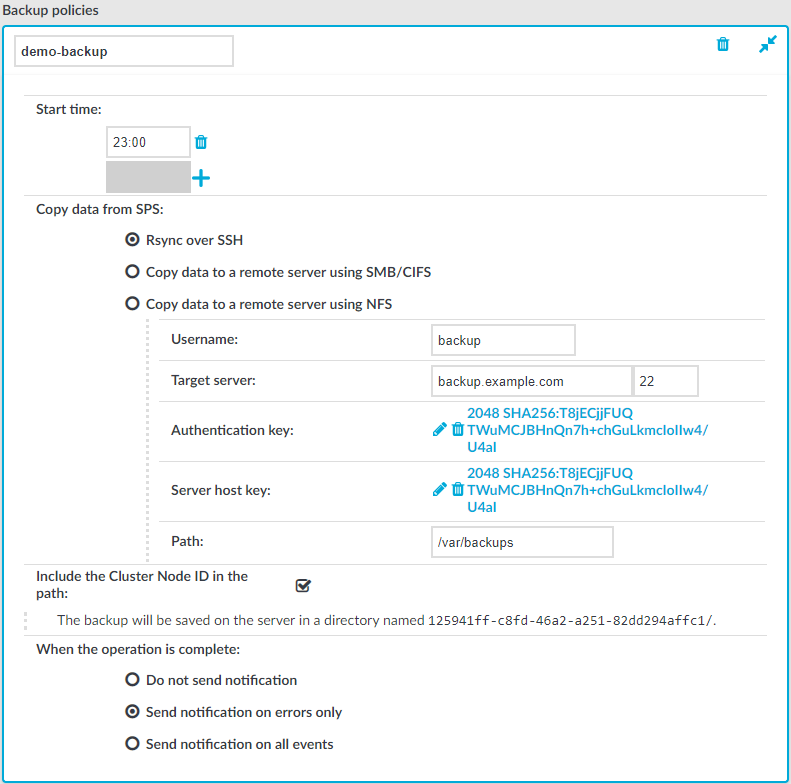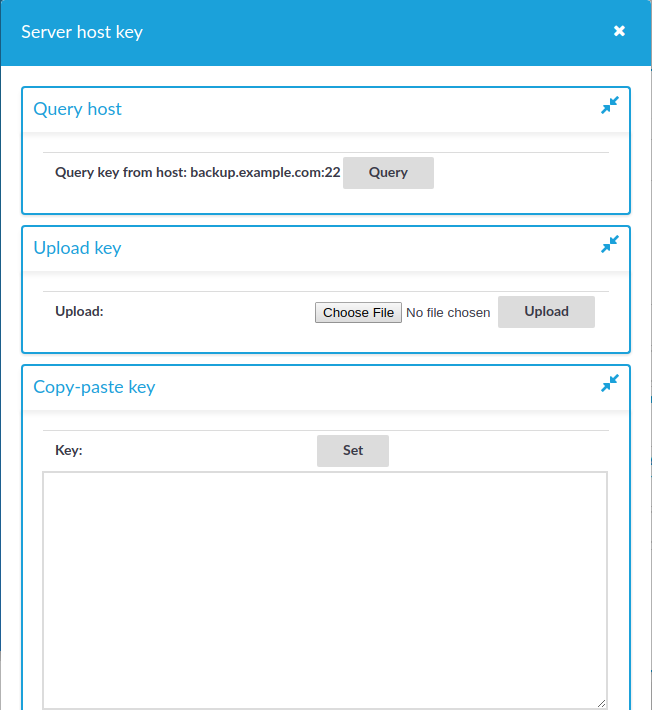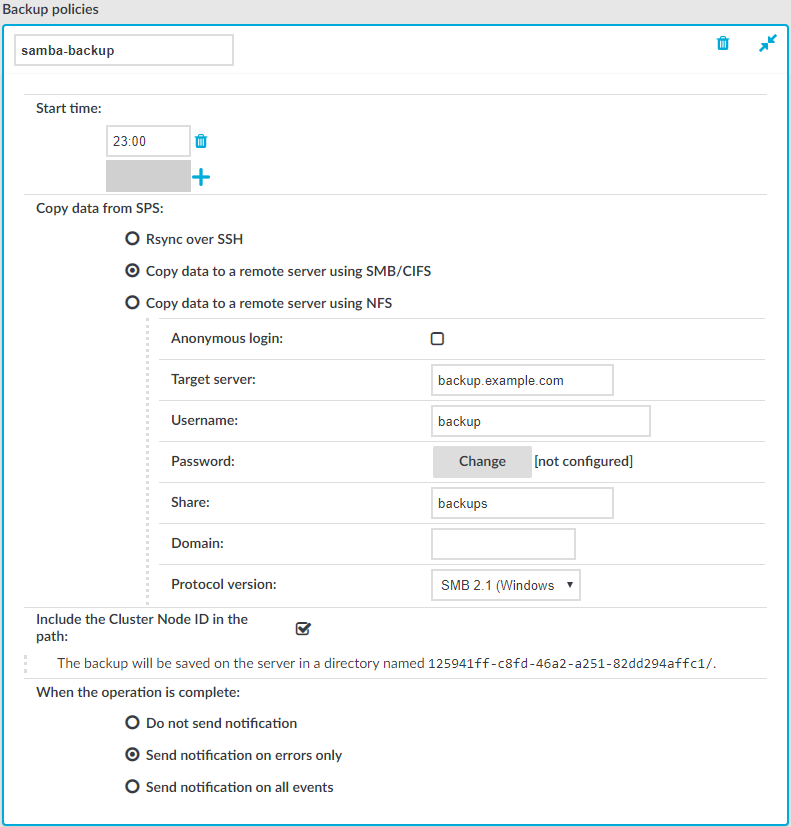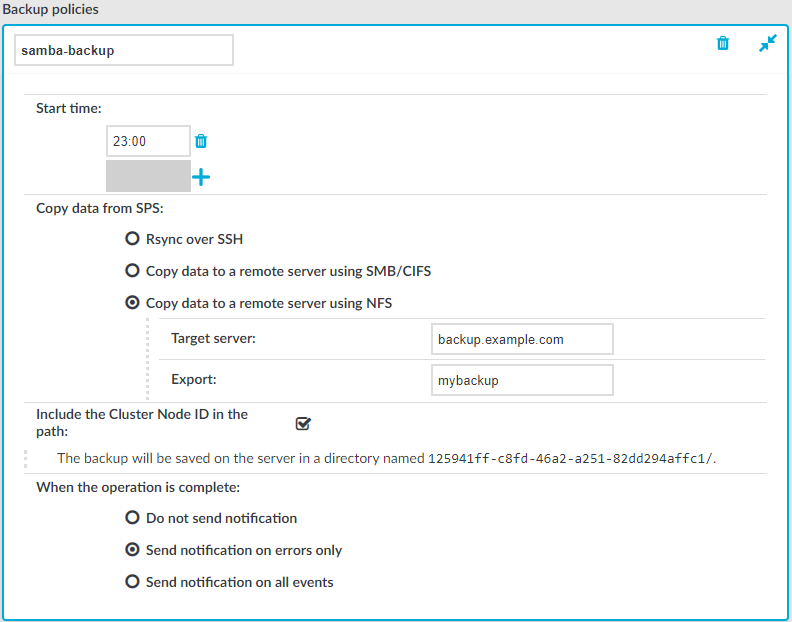Data and configuration backups
Backups create a snapshot of the configuration of One Identity Safeguard for Privileged Sessions (SPS) or the data which can be used for recovery in case of errors. SPS can create automatic backups of its configuration and the stored audit-trails to a remote server.
Configuring backups is a two-step process:
-
Create a backup policy.
-
Assign that policy to the system or a connection — depending on what it is that you wish to back up, SPS's configuration or a connection.
Creating a backup policy
Backup policies define the address of the backup server, which protocol to use to access it, and other parameters. SPS can be configured to use the Rsync, SMB/CIFS, and NFS protocols to access the backup server:
The different backup protocols assign different file ownerships to the files saved on the backup server. The owners of the backup files created using the different protocols are the following:
-
Rsync: The user provided on the web interface.
-
SMB/CIFS: The user provided on the web interface.
-
NFS: root with no-root-squash, nobody otherwise.
|

|
Caution:
SPS cannot modify the ownership of a file that already exists on the remote server. If you change the backup protocol but you use the same directory of the remote server to store the backups, make sure to adjust the ownership of the existing files according to the new protocol. Otherwise SPS cannot overwrite the files and the backup procedure fails. |
Assigning a backup policy
Once you have configured a backup policy, set it as a system backup policy (for configuration backups) or data backup policy (for connections backups):
Creating a backup policy using Rsync over SSH
The Rsync over SSH backup method connects the target server with SSH and executes the rsync UNIX command to copy the data to the remote server. SPS authenticates itself with a public key — password-based authentication is not supported.
|

|
Caution:
The backup server must run rsync version 3.0 or newer. |
To create a backup policy using Rsync over SSH
-
Navigate to Policies > Backup & Archive/Cleanup and click  in the Backup policies section to create a new backup policy.
in the Backup policies section to create a new backup policy.
-
Enter a name for the backup policy (for example, config-backup).
-
Enter the time when the backup process should start into the Start time field in HH:MM format (for example, 23:00).
You can add the start time for additional backup processes.
|

|
Caution:
When specifying an additional start time, ensure that the previous backup process finishes before the new backup process starts. |
-
Enter the IP address or the hostname of the remote server into the Target server field (for example, backup.example.com).
Use an IPv4 address.
-
Select Rsync over SSH from the Copy data from PSM radio buttons.
Figure 61: Policies > Backup & Archive/Cleanup > Backup policies — Configuring backups using rsync

-
Enter the username used to log on to the remote server into the Username field.
-
Click  in the Authentication key field. A popup window is displayed.
in the Authentication key field. A popup window is displayed.
-
Generate a new keypair by clicking Generate or upload or paste an existing one. This key will be used to authenticate SPS on the remote server. The public key of this keypair must be imported to the remote server.
-
Click  in the Server host key field. A popup window is displayed.
in the Server host key field. A popup window is displayed.
-
Click Query to download the host key of the server, or upload or paste the host key manually. SPS will compare the host key shown by the server to this key, and connect only if the two keys are identical.
Figure 62: Policies > Backup & Archive/Cleanup > Backup policies — Configuring SSH keys

-
Enter the port number of the SSH server running on the remote machine into the Port field.
-
Enter the path to the backup directory on the target server into the Path field (for example /backups).
SPS saves all data into this directory, automatically creating the subdirectories. Backups of audit-trails are stored in the data, configuration backups in the config subdirectory.
-
When your SPS instance is a node in a cluster, select Include the Cluster Node ID in the path. This ensures that the ID of the node is included in the path of the relevant directory, which is required to prevent cluster nodes from backing up data to the same location, and so overwriting each other's data and resulting in data loss. In addition, having the node's ID in the directory name also enables easy identification.
|

|
Caution:
Hazard of data loss
Unchecking Include the Cluster Node ID in the path when your SPS is a node in a cluster can result in data loss if you have configured configuration synchronization across your cluster nodes. |
-
To receive e-mail notification of the backup, select the Send notification on errors only or the Send notification on all events option. Notifications are sent to the administrator e-mail address set on the Management tab.
To include the list of files in the e-mail, select Send notification on all events and enable the Include file list option. However, note that if the list is very long (for example, SPS stores over 20000 audit trails), the SPS web interface might become unaccessible. In this case, set the Maximum number of files in notification lower. After this number has been reached, file names will be omitted from the notification.
NOTE: This e-mail notification is different from the one set on the Alerting & Monitoring tab. This notification is sent to the administrator's e-mail address, while the alerts are sent to the alert e-mail address (see Configuring system monitoring on SPS).
-
Click  .
.
-
To assign the backup policy to a connection, see Creating data backups.
Creating a backup policy using SMB/CIFS
The Copy data to a remote server using SMB/CIFS backup method connects to a share on the target server with Server Message Block protocol. SMB/CIFS is mainly used on Microsoft Windows Networks.
When deployed from the Azure Marketplace, you can use Azure File storage shares in your for Backup and Archive Policies. This is very useful as the quota for the files storage can be changed dynamically, so the cumulative size of the audit trails is not limited to the OS disk size. You can set up this share as a normal SMB shares in your Backup and Archive policies. The parameters for the policy can be obtained from the Azure portal.
NOTE: Backup and archive policies only work with existing shares and subdirectories.
If a server has a share at, for example, archive and that directory is empty, when the user configures archive/scb1 (or similar) as a backup/archive share, it will fail.
|

|
Caution:
When you try to create backups and archives from SPS to NetApp devices using the CIFS protocol, the operation may fail with a similar error message: /opt/scb/mnt/14719217504d41370514043/reports/2010": Permission denied (13) '2010/day/' rsync: failed to set times on.
To overcome this problem, grant the SPS user "Full Control" access rights to the CIFS share on the NetApp device. |
|

|
Caution:
When using the CIFS protocol to backup or archive files to a target server running Windows 2008 R2 that uses NTLMv2 authentication, the operation may fail with a similar error message: CIFS VFS: Unexpected SMB signature
Status code returned 0xc000000d NT_STATUS_INVALID_PARAMETER
CIFS VFS: Send error in SessSetup = -22
CIFS VFS: cifs_mount failed w/return code = -22
CIFS VFS: Server requires packet signing to be enabled in /proc/fs/cifs/SecurityFlags.
CIFS VFS: cifs_mount failed w/return code = -95
CIFS VFS: Server requires packet signing to be enabled in /proc/fs/cifs/SecurityFlags.
CIFS VFS: cifs_mount failed w/return code = -95
To overcome this problem, either:
-
use the NFS protocol to access your Windows 2008 R2 servers, or
-
edit the registry of the Windows 2008 R2 server or apply a hotfix. For details, see Article 957441 in the Microsoft Support site. |
-
Navigate to Policies > Backup & Archive/Cleanup and click  in the Backup policies section to create a new backup policy.
in the Backup policies section to create a new backup policy.
-
Enter a name for the backup policy (for example, config-backup).
-
Enter the time when the backup process should start into the Start time field in HH:MM format (for example, 23:00).
You can add the start time for additional backup processes.
|

|
Caution:
When specifying an additional start time, ensure that the previous backup process finishes before the new backup process starts. |
-
Enter the IP address or the hostname of the remote server into the Target server field (for example, backup.example.com).
Use an IPv4 address.
-
Select Copy data to a remote server using SMB/CIFS from the Copy data from PSM radio buttons.
Figure 63: Policies > Backup & Archive/Cleanup > Backup policies — Configuring backups through SMB/CIFS

-
Enter the username used to log on to the remote server into the Username field, or select the Anonymous login option.
Usernames can contain space.
-
Enter the password corresponding to the username into the Password field.
NOTE: One Identity Safeguard for Privileged Sessions (SPS) accepts passwords that are not longer than 150 characters. Letters A-Z, a-z, numbers 0-9, the space character, as well as the following special characters can be used: !"#$%&'()*+,-./:;<>=?@[]\^-`{}_|
-
Enter the name and directory path of the share into the Share field. Use the following format:
share_name/path/to/directory
You can use backslashes and forward slashes as well.
SPS saves all data into this directory, automatically creating the subdirectories. Backups of audit-trails are stored in the data, configuration backups in the config subdirectory.
-
Enter the domain name of the target server into the Domain field.
-
Select which SMB protocol to use when SPS connects to the server in the Protocol version field. Servers are usually backwards compatible with earlier protocol versions (for example, a server that supports version 2.1 supports versions 2.0 and 1.0 as well).
-
When your SPS instance is a node in a cluster, select Include the Cluster Node ID in the path. This ensures that the ID of the node is included in the path of the relevant directory, which is required to prevent cluster nodes from backing up data to the same location, and so overwriting each other's data and resulting in data loss. In addition, having the node's ID in the directory name also enables easy identification.
|

|
Caution:
Hazard of data loss
Unchecking Include the Cluster Node ID in the path when your SPS is a node in a cluster can result in data loss if you have configured configuration synchronization across your cluster nodes. |
-
To receive e-mail notification of the backup, select the Send notification on errors only or the Send notification on all events option. Notifications are sent to the administrator e-mail address set on the Management tab.
To include the list of files in the e-mail, select Send notification on all events and enable the Include file list option. However, note that if the list is very long (for example, SPS stores over 20000 audit trails), the SPS web interface might become unaccessible. In this case, set the Maximum number of files in notification lower. After this number has been reached, file names will be omitted from the notification.
NOTE: This e-mail notification is different from the one set on the Alerting & Monitoring tab. This notification is sent to the administrator's e-mail address, while the alerts are sent to the alert e-mail address (see Configuring system monitoring on SPS).
-
Click  .
.
-
To assign the backup policy to a connection, see Creating data backups.
Creating a backup policy using NFS
The Copy data to a remote server using NFS backup method connects to a shared directory of the target server with the Network File Share protocol.
NOTE: Backup and archive policies only work with existing shares and subdirectories.
If a server has a share at, for example, archive and that directory is empty, when the user configures archive/scb1 (or similar) as a backup/archive share, it will fail.
The version of NFS used is automatically detected. All versions of NFS, up to and including NFS version 4 protocol, are supported.
-
Navigate to Policies > Backup & Archive/Cleanup and click  in the Backup policies section to create a new backup policy.
in the Backup policies section to create a new backup policy.
-
Enter a name for the backup policy (for example, config-backup).
-
Enter the time when the backup process should start into the Start time field in HH:MM format (for example, 23:00).
You can add the start time for additional backup processes.
|

|
Caution:
When specifying an additional start time, ensure that the previous backup process finishes before the new backup process starts. |
-
Enter the IP address or the hostname of the remote server into the Target server field (for example, backup.example.com).
Use an IPv4 address.
-
Select Copy data to a remote server using NFS from the Copy data from PSM radio buttons.
Figure 64: Policies > Backup & Archive/Cleanup > Backup policies — Configuring NFS backups

-
Enter the domain name of the remote server into the Target server field.
-
Enter the name of the NFS export into the Export field.
SPS saves all data into this directory, automatically creating the subdirectories. Audit-trail backups are stored in the data, configuration backups in the config subdirectory.
-
The remote server must also be configured to accept backups from SPS.
Add a line that corresponds to the settings of SPS to the /etc/exports file of the backup server. This line should contain the following parameters:
-
The path to the backup directory as set in the Export field of the SPS backup policy.
-
The IP address of the SPS interface that is used to access the remote server. For more information on the network interfaces of SPS, see Network settings.
Use an IPv4 address.
-
The following parameters: (rw,no_root_squash,sync).
Example: Configuring NFS on the remote server
For example, if SPS connects the remote server from the 192.168.1.15 IP address and the data is saved into the /var/backups/SPS directory, add the following line to the /etc/exports file:
/var/backups/SPS 192.168.1.15(rw,no_root_squash,sync)
-
On the remote server, execute the following command:
exportfs -a
Verify that the rpc portmapper and rpc.statd applications are running.
-
When your SPS instance is a node in a cluster, select Include the Cluster Node ID in the path. This ensures that the ID of the node is included in the path of the relevant directory, which is required to prevent cluster nodes from backing up data to the same location, and so overwriting each other's data and resulting in data loss. In addition, having the node's ID in the directory name also enables easy identification.
|

|
Caution:
Hazard of data loss
Unchecking Include the Cluster Node ID in the path when your SPS is a node in a cluster can result in data loss if you have configured configuration synchronization across your cluster nodes. |
-
To receive e-mail notification of the backup, select the Send notification on errors only or the Send notification on all events option. Notifications are sent to the administrator e-mail address set on the Management tab.
To include the list of files in the e-mail, select Send notification on all events and enable the Include file list option. However, note that if the list is very long (for example, SPS stores over 20000 audit trails), the SPS web interface might become unaccessible. In this case, set the Maximum number of files in notification lower. After this number has been reached, file names will be omitted from the notification.
NOTE: This e-mail notification is different from the one set on the Alerting & Monitoring tab. This notification is sent to the administrator's e-mail address, while the alerts are sent to the alert e-mail address (see Configuring system monitoring on SPS).
-
Click  .
.
-
To assign the backup policy to a connection, see Creating data backups.


 in the Backup policies section to create a new backup policy.
in the Backup policies section to create a new backup policy.
 in the Authentication key field. A popup window is displayed.
in the Authentication key field. A popup window is displayed.
 .
.
